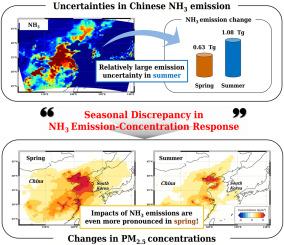中国NH3排放不确定性对中国大陆及下风地区PM2.5浓度的影响
IF 7.3
2区 环境科学与生态学
Q1 ENVIRONMENTAL SCIENCES
引用次数: 0
摘要
氨(NH3)排放的不确定性可通过大气化学反应影响环境细颗粒物(PM2.5)浓度。在这项研究中,我们使用社区多尺度空气质量(CMAQ)模型进行了数值模拟,以评估中国NH3排放的不确定性如何影响中国大陆及其下风地区的PM2.5浓度。我们通过将NH3排放量增加75.7%来设计2019年春夏的扰动情景,反映了之前研究报告的值。虽然夏季(2.00 mol /s)的排放量增幅大于春季(1.05 mol /s),但PM2.5浓度的变化在春季(2.54 μg/m3)比夏季(1.99 μg/m3)更为明显。春季PM2.5响应较大,与硝态氮(NO3-)产生-损失机制(NH3 + HNO3 + NH4+ + NO3-)有关。尽管夏季NH3排放量增加较多,但NO3-的净增加量低于春季,因为高温下NO3-的主导分解速率为- 1.229 μg/m3/h,抵消了产量。同时,天气风型的季节变化显著调节下风PM2.5浓度变化,这是由于排放异质性造成的。春季大气环流促进了NO3-向朝鲜半岛的有效跨界输送,导致逆风首尔的PM2.5浓度上升3.07 μg/m3,超过逆风北京的2.75 μg/m3。与此形成鲜明对比的是,夏季环流阻碍了NO3-平流,导致首尔的PM2.5变化仅为0.15 μg/m3,而北京为2.42 μg/m3。这些发现强调,中国NH3排放的变化可以深刻影响区域PM2.5水平,而气象条件,特别是风力模式,在决定东亚空气质量方面发挥着关键作用。本文章由计算机程序翻译,如有差异,请以英文原文为准。

Impacts of Uncertainties in Chinese NH3 Emissions on PM2.5 Concentrations over Mainland China and Downwind Regions
Uncertainties in ammonia (NH3) emissions can influence ambient fine particulate matter (PM2.5) concentrations through atmospheric chemical reactions. In this study, we performed numerical simulations using the Community Multiscale Air Quality (CMAQ) model to assess how uncertainties in Chinese NH3 emissions affect PM2.5 concentrations over mainland China and its downwind regions. We designed perturbation scenarios for spring and summer 2019 by increasing NH3 emissions by 75.7%, reflecting values reported in previous studies. Although the emission increase was larger in summer (2.00 moles/s) than in spring (1.05 moles/s), PM2.5 concentration changes were more pronounced in spring (2.54 μg/m3) than in summer (1.99 μg/m3). The greater PM2.5 response in spring is attributed to the nitrate (NO3-) production–loss mechanism (NH3 + HNO3 ⇌ NH4+ + NO3-). Despite the larger increase in NH3 emissions during summer, the net rise in NO3- was lower than in spring because the dominant NO3- decomposition rate of −1.229 μg/m3/h under higher temperatures offset production. Concurrently, seasonal shifts in synoptic wind patterns were found to significantly modulate downwind PM2.5 concentration variations attributable to emission heterogeneity. Springtime atmospheric circulation facilitated efficient transboundary transport of NO3- towards the Korean Peninsula, consequently elevating PM2.5 concentrations in downwind Seoul by 3.07 μg/m3, surpassing the 2.75 μg/m3 increase observed in upwind Beijing. In stark contrast, summertime circulation impeded NO3- advection, resulting in a mere 0.15 μg/m3 PM2.5 change in Seoul compared to 2.42 μg/m3 in Beijing. These findings underscore that variations in NH3 emissions from China can profoundly influence regional PM2.5 levels, and that meteorological conditions, particularly wind patterns, play a pivotal role in dictating East Asian air quality.
求助全文
通过发布文献求助,成功后即可免费获取论文全文。
去求助
来源期刊

Environmental Pollution
环境科学-环境科学
CiteScore
16.00
自引率
6.70%
发文量
2082
审稿时长
2.9 months
期刊介绍:
Environmental Pollution is an international peer-reviewed journal that publishes high-quality research papers and review articles covering all aspects of environmental pollution and its impacts on ecosystems and human health.
Subject areas include, but are not limited to:
• Sources and occurrences of pollutants that are clearly defined and measured in environmental compartments, food and food-related items, and human bodies;
• Interlinks between contaminant exposure and biological, ecological, and human health effects, including those of climate change;
• Contaminants of emerging concerns (including but not limited to antibiotic resistant microorganisms or genes, microplastics/nanoplastics, electronic wastes, light, and noise) and/or their biological, ecological, or human health effects;
• Laboratory and field studies on the remediation/mitigation of environmental pollution via new techniques and with clear links to biological, ecological, or human health effects;
• Modeling of pollution processes, patterns, or trends that is of clear environmental and/or human health interest;
• New techniques that measure and examine environmental occurrences, transport, behavior, and effects of pollutants within the environment or the laboratory, provided that they can be clearly used to address problems within regional or global environmental compartments.
 求助内容:
求助内容: 应助结果提醒方式:
应助结果提醒方式:


